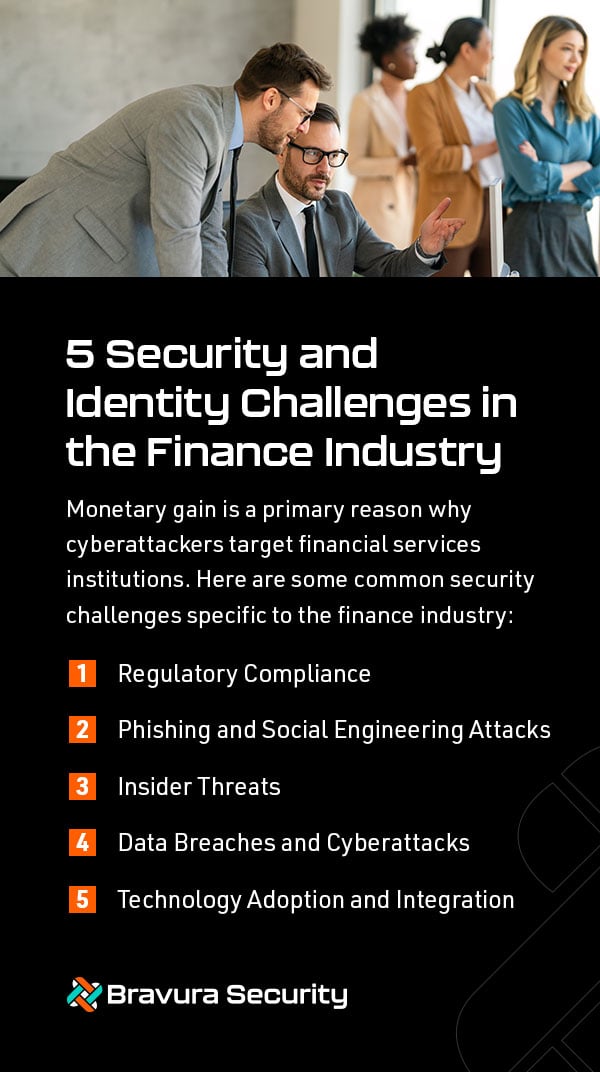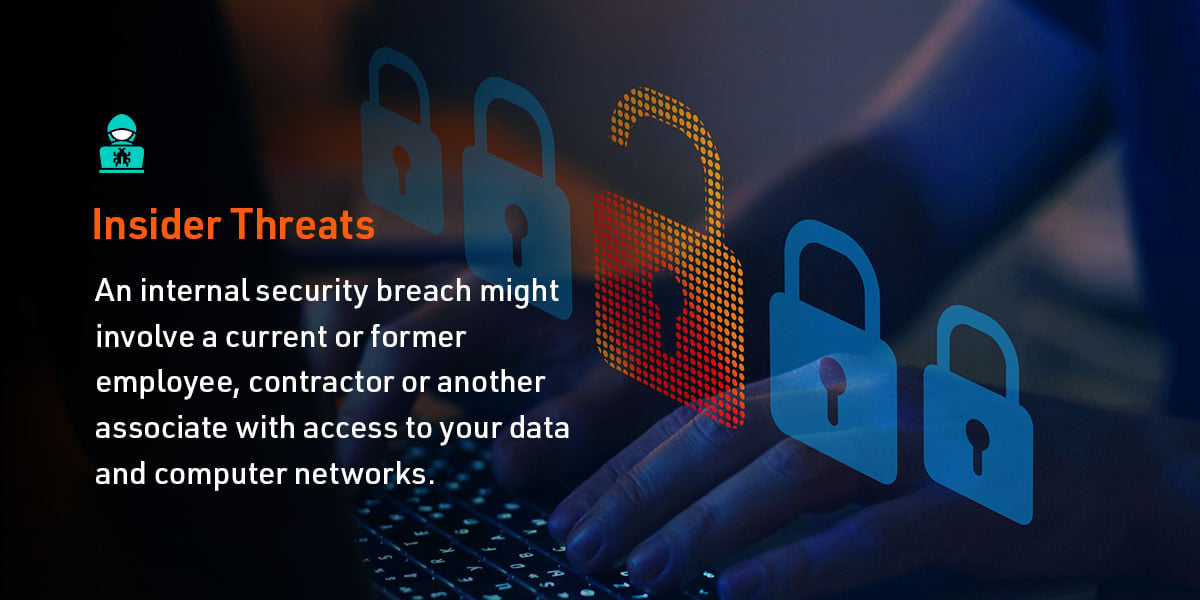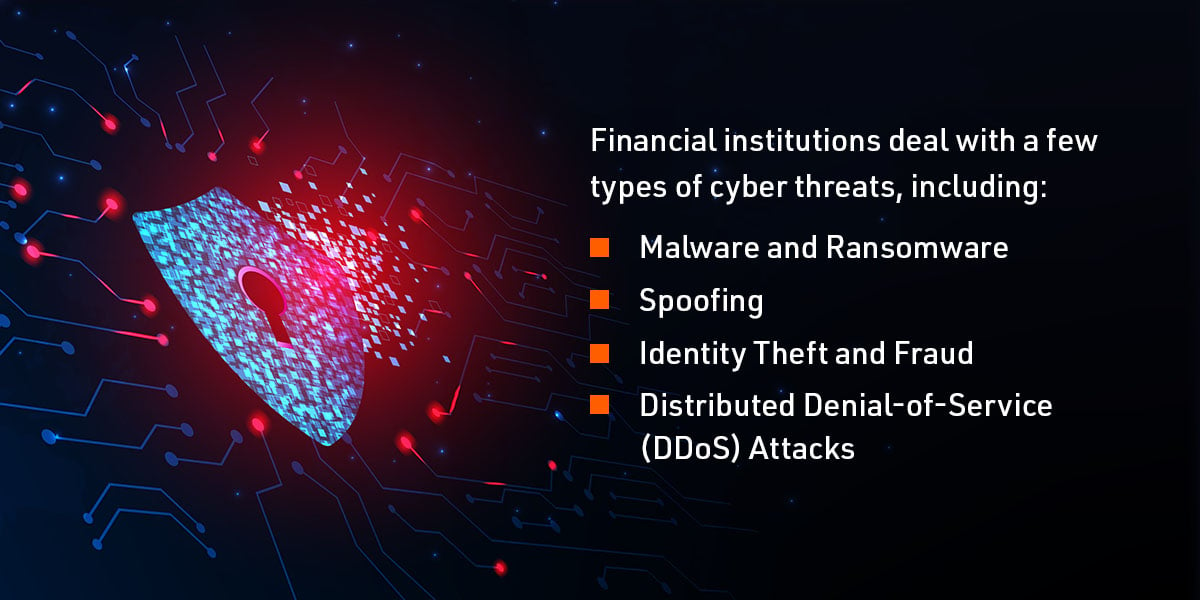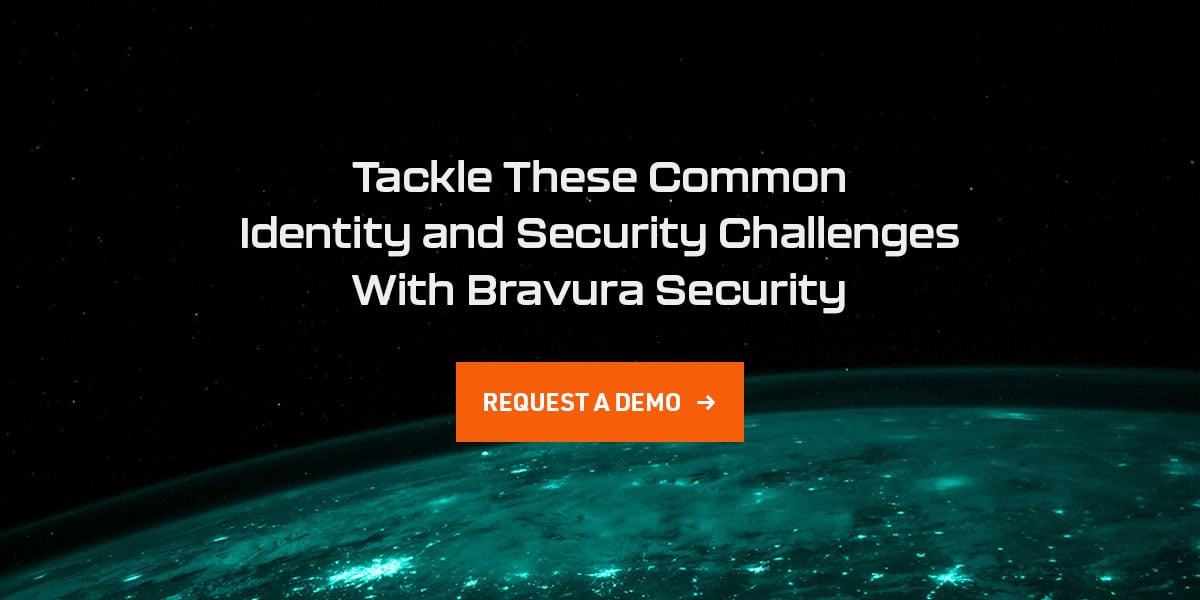Cybersecurity threats are prevalent in the financial sector. In 2024, finance and insurance was the second-most vulnerable industry to cyberattacks. This sector was involved in about 19% of global attacks, preceded by manufacturing at nearly 25%.
Banks and other financial organizations manage and store large amounts of client and monetary data. Naturally, this makes them prime targets for cybercriminals.They face a complex web of identity security challenges that require a unified approach to identity and access management and privileged access management as a part of an overall cybersecurity strategy. While point solutions may address individual threats, the interconnected nature of modern banking demands an integrated platform that can provide comprehensive protection.
What are some common cybersecurity risks financial institutions experience? What can you do to prevent them? In this guide, we'll dive into several security and identity risks facing the financial services industry. That way, you can recognize and avoid these challenges in your own business.
In This Article
- Regulatory Compliance
- Phishing and Social Engineering Attacks
- Insider Threats
- Data Breaches and Cyberattacks
- Technology Adoption and Integration
5 Security and Identity Challenges in the Finance Industry
Monetary gain is a primary reason why cyberattackers target financial services institutions. Considering financial data is the heart of this industry, any level of security breach can be damaging to your business and reduce clients' trust in your company.
Understanding the different security and identity challenges encountered within the financial services industry is pivotal. By recognizing these risks, you can implement the appropriate measures, tools and resources to mitigate them. Here are some common security challenges specific to the finance industry and ways to manage them.

1. Regulatory Compliance
Financial institutions must comply with a few security regulations, such as:
- Sarbanes-Oxley Act: The Sarbanes-Oxley (SOX) Act of 2002 aims to protect investors from fraudulent financial reporting. It states that all financial reports must include an Internal Controls Report. This report demonstrates that the institution has implemented adequate controls to safeguard its financial data and that all information is accurate. The SOX Act also requires end-of-year financial disclosure reports.
- Gram-Leach-Bliley Act: Also called the "Financial Services Modernization Act of 1999," the Gramm-Leach-Bliley Act requires financial institutions to disclose their information-sharing practices to their customers. These organizations must explain how they collect and safeguard their clients' confidential data.
- PCI DSS: The PCI Data Security Standard (PCI DSS) is a set of security regulations that aim to protect credit card transactions and data. It was enacted by the PCI Security Standards Council in 2004. There are multiple requirements for PCI DSS compliance, including the use of firewalls, password protection, transmitted data encryption and properly updated software.
Complying with these regulations is essential to reduce data breaches. Not following these protocols could lead to various consequences and disciplinary actions, including:
- Lost customers.
- Reputational damage.
- Financial losses, fines and penalties.
- License revocations.
However, meeting all mandatory regulations can be a challenge since they are constantly evolving. Fortunately, a few strategies can help you stay compliant with these guidelines:
- Stay informed about evolving regulations: Continuously stay on top of these changing policies and update your procedures as necessary. Regularly reviewing government websites, subscribing to industry newsletters, consulting with legal experts and attending conferences and seminars can help.
- Implement robust compliance frameworks: You can overcome compliance reporting challenges by integrating Identity Access Management (IAM) as a Service (IAMaaS). IAMaaS helps you collect real-time compliance data. It also automates tasks like application reporting, certification reviews and employee onboarding and offboarding. IAMaaS improves reporting efficiency, helping your organization give more accurate, thorough compliance data for auditors.
- Regular audits and documentation: Audits can help your business stay compliant with frequently changing federal requirements. They can identify risk areas for noncompliance within your company so you can adjust your procedures as necessary.
While maintaining compliance can be a costly and challenging venture for your organization, it results in more secure business practices and a better brand image. A unified identity and access management platform becomes essential for maintaining compliance across multiple regulations simultaneously. Rather than managing separate tools for SOX, GLBA, and PCI DSS compliance, an integrated solution provides centralized control and reporting. Your customers can have more peace of mind knowing their private information is protected, thus improving your reputation and attracting new clients.
2. Phishing and Social Engineering Attacks
A phishing attack is a fraudulent email, phone call or text message that appears to be from a legitimate source. Hackers use it to trick users into downloading malware or sharing sensitive information.
It's no surprise that cybercriminals frequently target the financial services sector with phishing attacks to gain monetary information. Nearly 23% of global phishing attacks targeted financial organizations in 2024.
Clients and employees alike are at risk regarding digital banking. Scammers may send messages appearing to be official bank alerts to customers in hopes of accessing their financial information. Additionally, financial institution employees may unknowingly give out credentials to client data due to a phishing scam.
To keep these attacks to a minimum, both internal and client-facing banking websites and applications should have strong safety protocols built in. Here are some prevention strategies for phishing and social engineering attacks:
- Employee training and awareness programs: Human error is a common culprit that leads to users failing to detect scams, causing small and large monetary losses. That's why it's essential to train your employees to recognize the signs of a phishing attempt. Employees should learn about different phishing scenarios, undergo simulations and learn how to report real phishing attempts to the security department.
- Multifactor Authentication (MFA): MFA methods like facial or fingerprint identification can be an effective defense against phishers attempting to steal credentials. Should an employee click a suspicious link resulting in stolen credentials, MFA creates a secondary security layer the thief can't bypass.
- Email filtering and security solutions: An anti-phishing email filter scans both inbound and outbound emails for suspicious content. If your account becomes compromised, the filter will block emails from being sent, protecting your domain authority.
3. Insider Threats

Around 34% of businesses worldwide experience an insider attack each year with insider threats also accounting for approximately 34% of all data breaches in financial institutions. An internal security breach might involve a current or former employee, contractor or another associate with access to your data and computer networks. They know the technologies, security protocols and business model your company uses. In some cases, they may have even helped design it.
There are two types of insider threats:
- People who unintentionally allow hackers into your network or give out sensitive data.
- People who deliberately and maliciously let hackers into your system or leak classified information.
An inadvertent data breach can occur from things like:
- Human error.
- Unknowingly responding to a phishing email or clicking a link embedded with malware.
- Mistakenly sending or exposing a company's client list or other critical information.
Meanwhile, intentional internal cybercrime might involve:
- Manipulating data to generate false expense reports.
- Stealing or modifying classified data for personal gain.
- Committing financial theft, such as embezzlement or fraud.
- Sabotaging a company's data network to gain revenge for a perceived injustice.
Whether an internal cybersecurity threat is intentional or unintentional, it can have severe consequences for your business, finances and image. Not to mention the penalties you could face from a regulator or auditor.
Here are some avoidance strategies for insider threats:
- Access control and the principle of least privilege: The principle of least privilege (PoLP) states that any employee, contractor or another associate should only access the information and functions necessary to perform their jobs. Allowing users the bare minimum privileges for their required tasks can help prevent internal threats. Privileged Access Management (PAM) software lets you exercise these principles, giving you more control over accounts and helping you maintain regulatory compliance.
- Employee monitoring and behavior analytics: Employee monitoring software lets you track user activities from one interface. You can detect and investigate any irregular behaviors.
- Clear security policies and reporting mechanisms: Communicate your cybersecurity protocols across your team. Employees should also know how to report any suspicious behaviors from other team members.
- Regular password changes: Periodically changing administrative passwords can also minimize insider threats. You can streamline this process with a PAM solution. This system randomizes passwords on a schedule or after each use. It prevents and hinders malicious internal attacks and can give clear audit trails of malicious internal activity.
Insider threats highlights a critical gap in traditional security approaches - the need to manage both privileged access and regular user identities in a coordinated way. When PAM and IAM operate in silos, organizations miss critical security insights and create potential vulnerabilities.
4. Data Breaches and Cyberattacks
Cyberattacks are one of the most common security challenges for the finance industry. While legacy systems present integration challenges, modern unified identity platforms are designed to work alongside existing infrastructure. This allows financial institutions to modernize their security gradually while maintaining critical operations and increasing protection. Financial institutions deal with a few types of cyber threats, including:

Malware and Ransomware
A 2024 survey found that ransomware attacks in financial institutions increased from 55% to 64%. Malicious software, or "malware," is a file or code scammers use to infect a computer network and steal money, passwords or other confidential information.
Ransomware is a type of malware that encrypts a user's files and prevents them from accessing their computer system. A cyberattacker then demands a ransom payment in exchange for access. They may threaten to block the system permanently or publish the user's confidential information online unless they pay.
Financial institutions manage sensitive monetary data for their clients, such as:
- Credit card numbers.
- Social security numbers.
- Checking and savings account numbers.
- Titles.
- Wills.
- Estate documents.
Many organizations store this information electronically, making it susceptible to ransomware attacks.
Spoofing
During a spoofing attack, a hacker disguises themselves as a trusted entity to gain access to a system or personal data. Spoofing can occur over the phone, an email or a text message. For instance, a hacker might spoof a bank's phone number to text or call its clients. The organization's caller ID will appear on the customer's device, making it challenging to determine if the message is real.
There is also domain spoofing. With this tactic, a cyberattacker creates a false version of an existing domain to trick users into revealing private information, such as login credentials. Domain spoofing relies on users not looking closely at whether a website appears legitimate. Regardless of the medium scammers use, all instances of spoofing involve some form of impersonation.
Each day, thousands of people fall victim to fraudulent emails, texts and phone calls from hackers masquerading as representatives from their banks. Even if customers can see through spoofing attempts, financial institutions should still take measures to identify and prevent them, as they can reduce clients' trust in your organization.
Identity Theft and Fraud
Fraud and theft are common identity challenges for the finance industry. These issues have skyrocketed in the past year, with 26% of banks reporting more than 100 cases of identity fraud. Scammers can easily purchase credentials on the dark web and use them to commit bank account fraud. They can also obtain them through data breaches, phishing attacks or social engineering scams.
While identity theft and fraud aren't new concepts in the financial services sector, they've evolved significantly with advancements in criminal internet activity. Fraudulent behavior can occur through a variety of channels. Plus, developing digital tactics can make them more challenging to identify. Bank account hackers have many options regarding identity theft, making it difficult for financial organizations to distinguish scammers from genuine users.
Effective cybersecurity protocols are important to detect suspicious account activity and fraudulent attempts. For instance, a user attempting to purchase something from an unusual location could mean a cybercriminal has stolen their information and is using it.
Distributed Denial-of-Service (DDoS) Attacks
During a DDoS attack, a cybercriminal temporarily or permanently disrupts a network's services, making them unavailable to their primary users. This is done by flooding servers with unnecessary traffic, which blocks legitimate traffic from getting through. As a result, your clients may be unable to access mobile banking apps, websites, portals or customer service resources.
Even brief downtime from a DDoS attack can be highly inconvenient for customers, decreasing their trust in a financial institution. DDoS prevention should be a high priority for your organization, as many users rely on digital channels for their banking activities.
How can you protect your business against the plethora of internet threats out there? Here are some robust avoidance strategies to minimize malware, spoofing, fraud and DDoS attacks:
- Strong encryption and data protection: Encryption uses unique codes that scramble plain text. That way, only those with the decryption key can read it. Should a data breach occur, encryption helps protect this confidential data, even if a hacker makes it past the firewall.
- Advanced Intrusion Detection System (IDS): An IDS maintains a database of attack signatures, comparing it against network packets. The IDS will flag any packet triggering a match to one of these signatures.
- Regular penetration testing: Penetration testing can help you detect vulnerabilities within your network, mobile apps, website and other systems. It simulates realistic attacks on your IT infrastructure, identifying any cybersecurity flaws hackers could exploit.
5. Technology Adoption and Integration
Many financial institutions use decades-old legacy banking systems. These outdated systems may not support modern applications and software, making it difficult for banks to integrate new technologies. By working with a knowledgeable software solutions provider, you can adopt new technologies and enhance your cybersecurity protocols.
Here are some methods to navigate technology adoption and integration challenges:
- Conduct a thorough vendor assessment: Ensuring you partner with a credible and trustworthy third party for software integration is a crucial measure. Conduct a thorough vendor assessment to ensure they can meet your organization's security needs and goals.
- Create a robust technology adoption roadmap: A technology roadmap visually lays out the plans and goals for your company's technology integration. To develop this roadmap, you should identify strategic objectives and assign different responsibilities to your team members. Regularly review and assess your roadmap, making adjustments as needed.
- Invest in seamless integration solutions: An experienced vendor can assist you with software integration and configuration, helping you bring your technology adoption roadmap to life.

Tackle These Common Identity and Security Challenges With Bravura Security
Are you looking to manage issues like internal threats, regulatory compliance challenges and malware attacks? If so, partnering with a knowledgeable software solutions company is a proactive step. At Bravura Security, we specialize in identity and security solutions for various industries, including the financial sector.
We offer a range of products and solutions to help improve various aspects of your cybersecurity protocols. With our products, you can get:
- Privileged access, password and identity management.
- Identity security analytics.
- Multifactor authentication.
- Regulatory compliance.
- Cloud security.
With clients' critical financial records in your hands, robust cybersecurity measures are nonnegotiable for your institution. Bravura Security's unified platform approach combines industry-leading IAM and PAM capabilities in a single solution, eliminating security gaps while simplifying compliance and administration. This integrated strategy provides financial institutions with comprehensive protection against both external threats and insider risks. Consider partnering with Bravura Security for industry-leading solutions. Learn more about our software by requesting a demo today!
Related Articles
Access Control and Identity Management Best Practices
Companies worldwide are rapidly turning to digital solutions. From online communication methods to productivity applications, technology offers ways to streamline...
The Chaos of Identity: Beyond IAM for Ransomware and Security Challenges
Ransomware attacks are increasingly disruptive, sophisticated and continue to plague organizations across all industries, from gasoline suppliers to higher education...